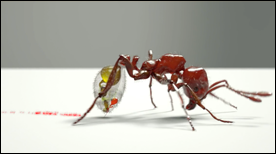Entomology Animated Episode 1: RIFA Madness | Eric Keller

A stunning and humorous animation that explains the venom of the infamous fire ant species Solenopsis invicta.
» View the animationPlease email info@clarafi.com with new recommendations for the showcase (include the title and link).

A stunning and humorous animation that explains the venom of the infamous fire ant species Solenopsis invicta.
» View the animation
An entertaining animation demonstrating the chemistry of the amazing defense mechanism of the Bombardier Beetle.
» View the animation
This 2-part Maya animation depicts the process of nucleic acid packing/assembly into the viral capsid. Part I shows the process simultaneous with the measured kinetics of packing and force (displayed on the right).
» View the animation
This 2-part Maya animation depicts the process of nucleic acid packing/assembly into the viral capsid. Part II focuses on the molecular machinery responsible for pulling the nucleic aacid strand inside the capsid.
» View the animation
This Maya animation depicts the process by which the translating ribosome is halted by the signal recognition particle (SRP). The ribosome is subsequently brought to the membrane and docked with a channel to translocate the nascent polypeptide chain.
» View the animation at Bloopatone
Shows fat cells in the adipose tissue adjacent to muscle – storage / breakdown of the cell’s fat droplet affects the balance of secreted adiponectin and resistin hormones. The effect of drugs against PPAR gamma is also shown to affect this balance and resulting insulin sensitivity.
» View the animation at HHMI
Shows the effects of drug-binding to the PPAR-delta transcription factor receptor on DNA – a repressor is released thereby turning on the muscle delta network on genes. Oxidative metabolism is activated and leads to reduction of fat pads in adipose tissue.
» View the animation at HHMI
This animation highlights the structure of p53 protein and its binding to a cognate promoter. Recruitment of RNA polymerase and transcription are also shown.
» View the animation at HHMI
This animation show the effects of MECP2 DNA methylation (CpG islands) on recruitment of Sina3/HDAC, nuclesome modification and gene silencing.
» View the animation at HHMI
This animation, created for Hans Clevers’ lab, shows how the entire surface of the intestine is populated via a “clonal conveyor belt” mechanism. Daughter cells born from stem cells located at the base of the crypts travel up and differentiate, thereby pushing existing cells up towards the villus tip (the oldest cells are jetisoned via apoptosis at the villus tip). Adenoma formation is also shown.
» View the animation
This Maya animation depicts the process of ubiquitin-dependent degradation in the proteasome. The effect of mutant ataxin no this process is also shown.
» View the animation
Dimerization of FKBP12 & FRAP is shown upon binding of the small molecule rapamycin.
» View the animation
A step-by-step depiction of a diversity-oriented organic synthesis reaction on beads (created for Professor Stuart Schreiber at Harvard/Broad). At the same time as the camera follows the reaction in 3D showing bond rearrangements, the viewer can simultaneously follow the reaction in standard stick notation at the bottom of the screen.
» View the animation at National Institute of General Medical Sciences - NIGMS